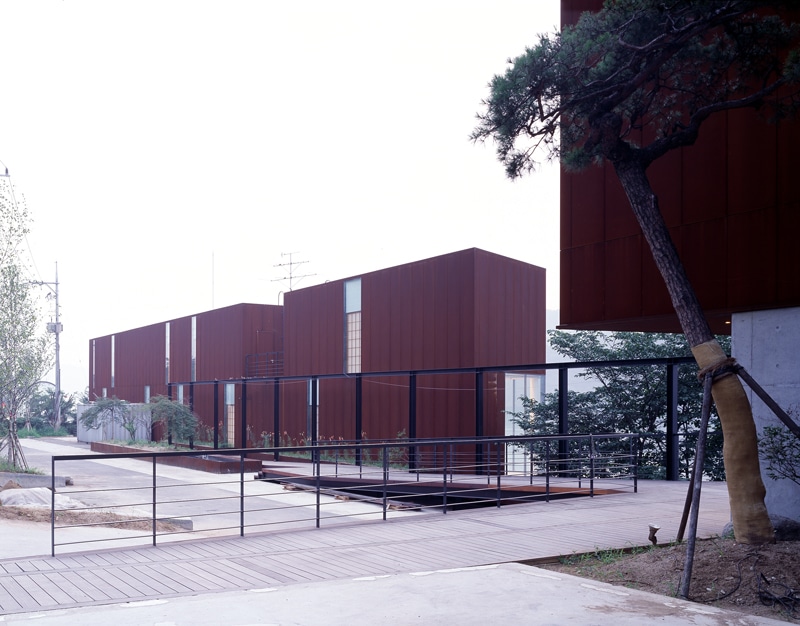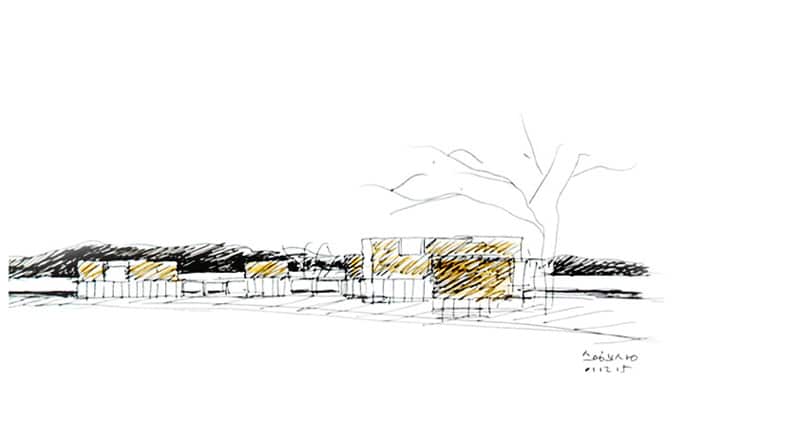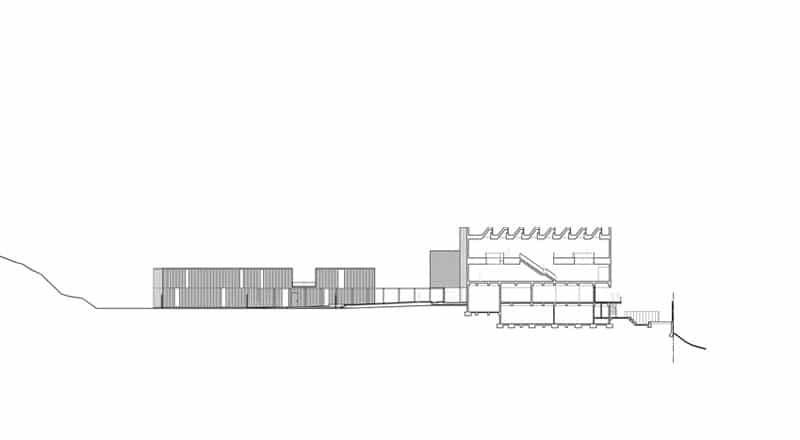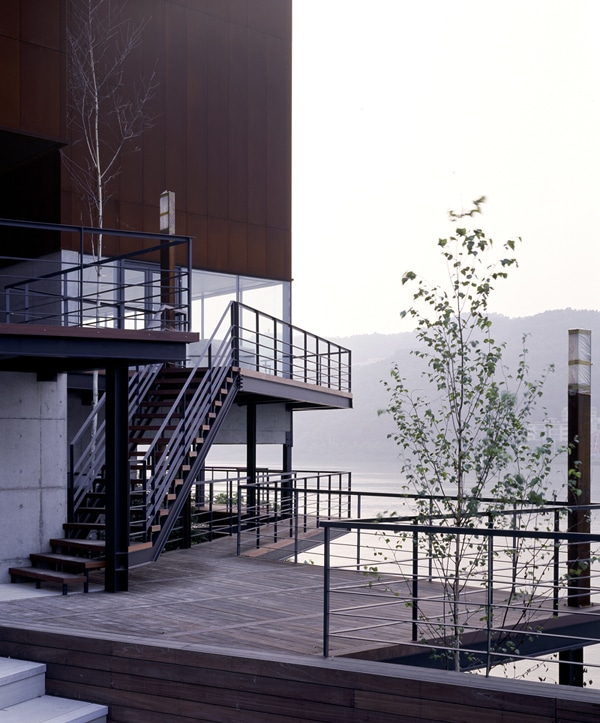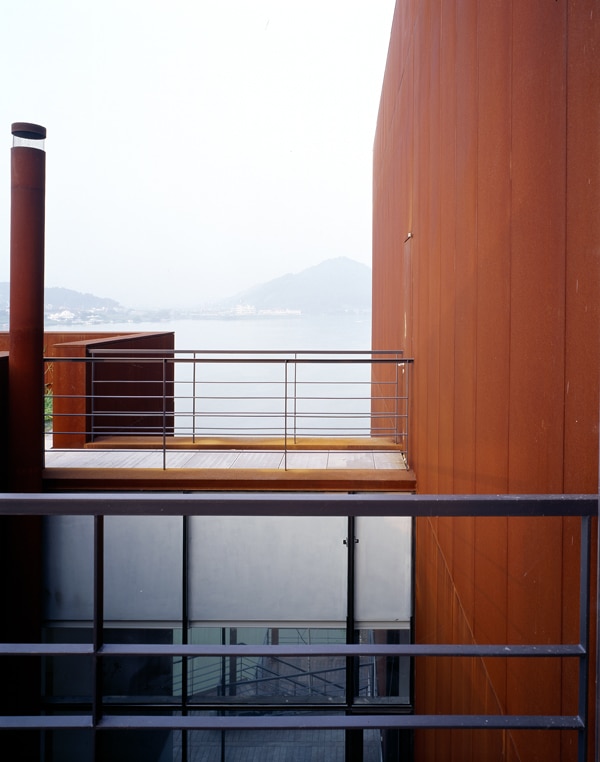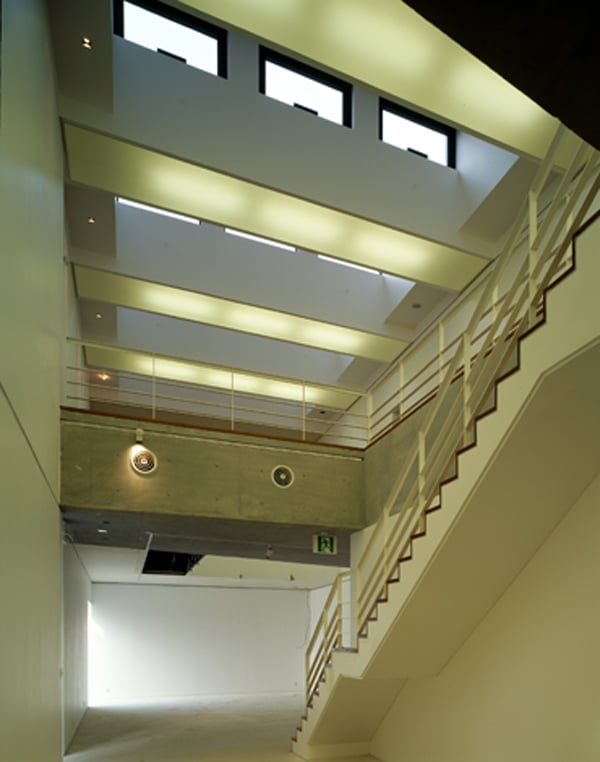Dr. Park Art Center
| 완공년도 | 2005 |
| 위치 | 경기도 양평 |
| 대지면적 | 1,765㎡ |
| 건축면적 | 527㎡ |
| 연면적 | 1,163㎡ |
| Scale | B1, 3F |
| 완공년도 | 2005 |
| 위치 | 경기도 양평 |
| 대지면적 | 1,765㎡ |
| 건축면적 | 527㎡ |
| 연면적 | 1,163㎡ |
| Scale | B1, 3F |
남한강변 복포리의 주택-노헌 설계가 거의 끝나 가던 무렵 강 건너편 땅에 미술관의 설계를 의뢰 받게 되었다. 좋은 기회인 것을 직감했다. 거의 항상, 처음 만나는 건축주에게는 경계의 눈빛을 감추지 않는 나이지만 두 말 않고 하겠다고 대답해 버렸던 것을 기억한다. 만약에 성공적으로 이 두 프로젝트가 완성이 된다면, 그래서 이 세기말의 유희와 방종에 탐닉하는 강변 풍경에 적당한 긴장을 조성하게 된다면, 이 신음하는 강을 위로하는 작은 기회일 수 있지 않을까…..순진 무구한 생각을 가진 것이다. 햇살 때문에 눈부신 남쪽 강에 비해 북쪽에 흐르는 강은 풍경이 항상 선명하다. 그래서 대개의 경우 북쪽 강변에는 주택지가 발달하고 남쪽에는 호텔이나 음식점 같은 상업시설이 들어서게 된다. 그러나 북쪽 강변에 지어진 건축물들은 그 통상적 풍경과는 무관하여 천민상업성을 들어낸 채 괴이하기 그지 없지만 그래도 거대한 스케일의 강물에 다소 숨겨질 수 있었다. 이 건축으로 건너편 산과 남한강의 빛나는 풍경을 근사하게 담을 수 있으면 그것으로 나의 임무는 완수되는 것이다. 건축주는 내과 의사인데 오래 전부터 미술품을 수집하게 되어 이제는 전문적인 아트 콜렉터로서 상당한 명성을 쌓은 분이었다. 이미 수집한 물량도 대단하거니와 여느 미술관과는 달리 오랫동안 몇 작가에게만 집중하여 수집한 까닭에 그 분야에는 다른 미술관이 따라 올 수 없는 성과를 이루고 있는 것을 알게 되었다. 주거시설도 같이 짓는 이 미술관의 땅은, 강변의 땅들이 대개 그렇듯 노헌의 땅만큼 길다란 형상을 가지고 있다. 노헌은 국도에서는 다시 작은 길로 들어 가 접근하므로 길에서는 볼 수가 없지만 이 땅은 빠른 속도로 질주하는 차량이 많은 도로와 강 사이에 있어 도로에 무방비로 노출되어 있었다. 보행인구가 거의 없는 이 지역에 접근하는 방식은 차량에 의할 수 밖에 없다. 특히 이 좁고 긴 땅은 국도가 휘어서 돌아가는 곳에 위치하므로 그 접근이 다소 긴박하여 건축물은 급작스레 나타난다. 속도를 줄여 이 건축의 광경을 받아들일 준비를 하게 하는 반복적 장치가 필요하다고 여겼다. 강과 도로가 가지는 법규제한으로 상당부분이 불과 6m 폭의 건물 밖에 지을 수 없게 되어 있었다. 이런 특별한 땅의 모양은 계획에 강한 영향을 줄 수 밖에 없다. 또한 이런 긴 땅에 단일 건물로 채워 강의 풍경을 독점하는 것은 좋지 못하다. 적어도 건축을 통해 강변이 더욱 아름답게 보여져야 한다. 이런 이유로 전체 매스는 주거시설과 미술관 두 부분으로 나누고, 미술관도 몇 개로 다시 분절하여 그 사이에 놓인 적절한 간격의 공간으로 강과 도로와의 소통을 담당케 하였다. 이 분절된 매스들은 모여서 일단의 풍경을 만든다. 강이 흐르는 방향으로 긴 평행선을 갖지만 서로는 불규칙한 절단면을 단부로 가지면서 어긋난다. 어긋난 매스와 그 사이에 흐르는 공간, 사물들 그리고 건너의 유장한 물길, 이들이 만드는 특별한 풍경이 질주하려던 차량의 속도를 줄이게 할 것이다. 이 매스들의 마감재는 내후성 강판이다. 푸른 산과 물을 배경으로 암적색의 매스는 아름다운 조화를 만든다. 물론 몇 개의 녹 쓴 철 덩이가 만드는 예각의 풍경이 심상치 않은 리차드 세라의 조각처럼 보일 것이라는 생각도 없진 않지만, 그보다는 여기 참을 수 없이 가벼운 우리 시대 풍경에 다시 중심추로 그 무게감을 강제해야 한다는 강박관념이 다시 이 재료를 여기에 쓰게 했다. 강 건너에서 이들을 보면 역광일 수 밖에 없어, 건축의 형태구성보다는 매스감의 강조가 이 땅을 인식하는데 더욱 도움 될 것이라는 생각도 또 있었다. 그래도 폭풍처럼 몰려오는 천민상업주의의 비열함은 여전히 기세 등등하여 나는 이내 나의 무기력함을 처절히 실감해야 했다.
When the design of Reed House at Bokpo-ri by the Namhan riverside was almost completed, I received a project for a gallery located on the other side of the river. Although I am usually deliberate in discussing projects with new clients, in this case I remember accepting the commission almost immediately. If these projects on each side of the river were done successfully and create a proper tension to the riverside scene, it would bring some consolation to the environment moaning under an unhinged air of pleasure-seeking and dissoluteness at the end of the century. This was my pure and somewhat simple approach. While the southern scene of the river is drenched in glazing sunlight, its northern scenery is always crisp and clear. Hence, residential districts are usually formed on the north riverside and commercial facilitates on the south. Buildings on north riverside—products of vulgar commercialism—display grotesque appearance, but such inappropriate scene is fortunately overwhelmed by nature’s huge canvas. If this project effectively frames the magnificent scenery of the dashing Namhan river and the mountain on the other side of the river, my mission is accomplished. The client, a physician, has been collecting works of art for a long time and is renowned as an art collector. Because of its sheer bulk, and because such it is focused on the works of only a few artists, his collection has an exceptional value that sets it apart from those of other galleries. The site of the project, consisting of a gallery and a residence, has a linear shape like other plots on the riverside. It is also placed right next to the road, directly exposing its environment to speeding vehicles. The approach to the museum is mainly made by car, and because the narrow site is located in a curved portion of the road, the building appears all of a sudden. Required in this context was a method to slow down the passers’ velocity and prepare them for this building’s scenery.
Due to the building code, the width of the building for the most part is restricted to only six meters. Besides, the narrowness of the site sets certain limits to the building’s form. Under these circumstances, it seemed inappropriate to design a single building on such linear site and keep the river’s scenery to itself. The building should at least add to the beauty of the riverside, not appropriate it. This is why the mass is divided into two major parts—the residence and the gallery. The gallery, then, was also articulated to have inner voids, which provided proper space to facilitate the communication with the river and the road. The collection of such divided masses creates the overall scenery—although its linear form runs parallel to the river, its divisions, fractured with irregular sections, run into each other. Split masses, spaces and objects running through their in-between voids, and the grand view of the river behind them, will together form a peculiar landscape that will catch the eyes of the speeding driver. The masses are finished with cor-ten steel, whose garnet surface melts into the green mountains and the river. This set of rusty iron pieces with acute angles may look like a work by Richard Serra, but the choice of the material—which has been my favorite for some time—was based on my obsession to introduce a certain weight into this scenery of unbearable lightness. In addition, since the view from the other side of the river faces the sun, the building would be better recognized when its volume, rather than its formal composition, is highlighted. Despite such intention, the overflowing wave of vulgar commercialism lost no momentum, and I could not but recognize the limits of an architect’s efforts.

